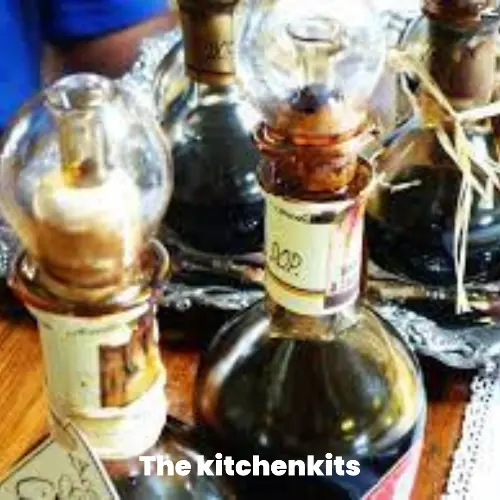Thekitchenkits.online is an Amazon Associate and earns from qualifying purchases made through affiliate links on our site at no extra cost to you. This supports our efforts to bring you valuable kitchen-related content.
Table of Contents
how to open Balsamic vinegar bottle
Opening a balsamic vinegar bottle can be tricky, especially if you’re dealing with a particularly old or hard-to-open bottle. In this article you will get a detailed guide on how to open Balsamic vinegar bottle
Here are a few tips to help you get the cap off:
- Use a bottle opener: A bottle opener can be a great tool for opening balsamic vinegar bottles. Simply place the opener over the cap and twist to remove it.
- Use a butter knife: If you don’t have a bottle opener on hand, a butter knife can also be used to remove the cap. Simply place the knife under the cap and twist to loosen it.
- Run the bottle under hot water: If the cap is particularly stubborn, try running the bottle under hot water for a few seconds. The heat can help loosen the cap and make it easier to remove.
- Tap the cap: Tapping the cap lightly on a hard surface can also help loosen it.
- Use a screwdriver: a screwdriver is also a good option to open the bottle if all else fails.
Types of Balsamic Vinegar:
Balsamic vinegar is a versatile ingredient that can be used in a variety of ways. There are several different types of balsamic vinegar, each with its own unique flavor and use.
Traditional Balsamic Vinegar: This is the most traditional type of balsamic vinegar, made from a blend of grape must and wine vinegar. It is aged for a minimum of 12 years and has a rich, complex flavor.
Commercial Balsamic Vinegar: This type of balsamic vinegar is made quickly and is aged for a shorter period of time. It is less expensive than traditional balsamic vinegar and has a milder flavor.
Condiment Balsamic Vinegar: This type of balsamic vinegar is made with a higher concentration of grape must and is aged for a shorter period of time. It is sweeter and thicker than traditional balsamic vinegar, making it a great option for drizzling over salads, meats, and cheeses.
White Balsamic Vinegar: This type of balsamic vinegar is made from white grapes and is aged for a shorter period of time. It has a lighter color and a milder flavor than traditional balsamic vinegar.
Is Balsamic Vinegar a Bad Thing?
Balsamic vinegar is not a bad thing, in fact, it is a healthy addition to many dishes. Balsamic vinegar is made from grapes, which are a good source of antioxidants. It is also a good source of acetic acid, which can help lower blood sugar levels and improve insulin sensitivity. However, it is high in calories and sugar, so it should be used in moderation.
How to Store Balsamic Vinegar?
Balsamic vinegar should be stored in a cool, dark place, away from light and heat. The ideal storage temperature is between 50 and 70 degrees Fahrenheit. Balsamic vinegar can also be stored in the refrigerator, but it may become thicker and more difficult to pour. It’s important to keep the bottle tightly sealed to prevent air from entering, which can cause the vinegar to spoil.
How Long Does Balsamic Vinegar Last?
Balsamic vinegar has a long shelf life, but the flavor and quality can deteriorate over time. If stored properly, traditional balsamic vinegar can last for several decades, while commercial and condiment balsamic vinegar can last for several years. To determine if balsamic vinegar has gone bad, check for a sour.
Does balsamic vinegar need refrigeration?
No, balsamic vinegar does not need to be refrigerated. In fact, storing it in the refrigerator can cause it to thicken and become more difficult to pour. It is best to keep balsamic vinegar in a cool, dark place, away from light and heat. The ideal storage temperature is between 50 and 70 degrees Fahrenheit. It is important to keep the bottle tightly sealed to prevent air from entering, which can cause the vinegar to spoil.
Conclusion
Opening a bottle Of balsamic vinegar is quite easy. If you pick the right tools and pick th best method without any extra effort . We hope this article will be helpful to you. If you have any question let us know.
FAQs
Is balsamic vinegar gluten-free?
Yes, traditional balsamic vinegars are gluten-free as they are made from grapes and wine vinegar, which do not contain gluten. However, it is always best to check the label or ask the manufacturer to confirm if any additional ingredients or cross-contamination may have occurred.
When does flavor infusion occur?
Flavor infusion occurs during the aging process of balsamic vinegar. The vinegar is aged in barrels made of different woods, such as oak, chestnut, and cherry, which infuse the vinegar with unique flavors and aromas.
How is white balsamic vinegar produced?
White balsamic vinegar is produced by cooking white grapes, rather than the traditional dark grapes, to create lighter-colored and milder-flavored vinegar. It is also aged for a shorter period of time than traditional balsamic vinegar.

I’m Ian Welkins, a seasoned professional in the kitchen industry. My passion now drives me to provide invaluable insights into the world of top-notch kitchen products. With years of hands-on experience, I’m your go-to source for culinary excellence.


